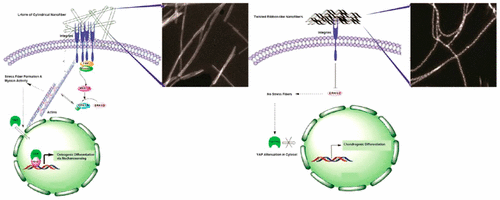当前位置:
X-MOL 学术
›
Biomacromolecules
›
论文详情
Our official English website, www.x-mol.net, welcomes your
feedback! (Note: you will need to create a separate account there.)
Supramolecular Peptide Nanofiber Morphology Affects Mechanotransduction of Stem Cells
Biomacromolecules ( IF 5.5 ) Pub Date : 2017-09-12 00:00:00 , DOI: 10.1021/acs.biomac.7b00773 Elif Arslan , Meryem Hatip Koc , Ozge Uysal , Begum Dikecoglu , Ahmet E. Topal , Ruslan Garifullin 1 , Alper D. Ozkan , Aykutlu Dana , Daniel Hermida-Merino 2 , Valeria Castelletto 3 , Charlotte Edwards-Gayle 3 , Sefer Baday 4 , Ian Hamley 3 , Ayse B. Tekinay , Mustafa O. Guler 5
Biomacromolecules ( IF 5.5 ) Pub Date : 2017-09-12 00:00:00 , DOI: 10.1021/acs.biomac.7b00773 Elif Arslan , Meryem Hatip Koc , Ozge Uysal , Begum Dikecoglu , Ahmet E. Topal , Ruslan Garifullin 1 , Alper D. Ozkan , Aykutlu Dana , Daniel Hermida-Merino 2 , Valeria Castelletto 3 , Charlotte Edwards-Gayle 3 , Sefer Baday 4 , Ian Hamley 3 , Ayse B. Tekinay , Mustafa O. Guler 5
Affiliation

|
Chirality and morphology are essential factors for protein function and interactions with other biomacromolecules. Extracellular matrix (ECM) proteins are also similar to other proteins in this sense; however, the complexity of the natural ECM makes it difficult to study these factors at the cellular level. The synthetic peptide nanomaterials harbor great promise in mimicking specific ECM molecules as model systems. In this work, we demonstrate that mechanosensory responses of stem cells are directly regulated by the chirality and morphology of ECM-mimetic peptide nanofibers with strictly controlled characteristics. Structural signals presented on l-amino acid containing cylindrical nanofibers (l-VV) favored the formation of integrin β1-based focal adhesion complexes, which increased the osteogenic potential of stem cells through the activation of nuclear YAP. On the other hand, twisted ribbon-like nanofibers (l-FF and d-FF) guided the cells into round shapes and decreased the formation of focal adhesion complexes, which resulted in the confinement of YAP proteins in the cytosol and a corresponding decrease in osteogenic potential. Interestingly, the d-form of twisted-ribbon like nanofibers (d-FF) increased the chondrogenic potential of stem cells more than their l-form (l-FF). Our results provide new insights into the importance and relevance of morphology and chirality of nanomaterials in their interactions with cells and reveal that precise control over the chemical and physical properties of nanostructures can affect stem cell fate even without the incorporation of specific epitopes.
中文翻译:

超分子肽纳米纤维形态影响干细胞的机械转导。
手性和形态是蛋白质功能以及与其他生物大分子相互作用的必不可少的因素。从这个意义上说,细胞外基质(ECM)蛋白也与其他蛋白相似。然而,天然ECM的复杂性使得难以在细胞水平上研究这些因素。合成肽纳米材料在模仿特定ECM分子作为模型系统方面具有广阔的前景。在这项工作中,我们证明了干细胞的机械感官反应直接受到具有严格受控特性的ECM模拟肽纳米纤维的手性和形态的直接调节。在包含l-氨基酸的圆柱形纳米纤维上呈现的结构信号(l-VV)有利于形成基于整合素β1的粘着斑复合物,该复合物通过激活核YAP增加了干细胞的成骨潜能。另一方面,扭曲的带状纳米纤维(1 - FF和d- FF)将细胞引导成圆形,并减少了粘着斑复合物的形成,这导致YAP蛋白被限制在胞质溶胶中,相应的减少了。成骨潜能。有趣的是,扭曲带状纳米纤维的d型(d -FF)比其l型增加了干细胞的成软骨潜能(l-FF)。我们的结果为纳米材料在与细胞相互作用中的形态和手性的重要性和相关性提供了新的见解,并揭示了对纳米结构的化学和物理性质的精确控制即使不掺入特定的表位也可以影响干细胞的命运。
更新日期:2017-09-12
中文翻译:

超分子肽纳米纤维形态影响干细胞的机械转导。
手性和形态是蛋白质功能以及与其他生物大分子相互作用的必不可少的因素。从这个意义上说,细胞外基质(ECM)蛋白也与其他蛋白相似。然而,天然ECM的复杂性使得难以在细胞水平上研究这些因素。合成肽纳米材料在模仿特定ECM分子作为模型系统方面具有广阔的前景。在这项工作中,我们证明了干细胞的机械感官反应直接受到具有严格受控特性的ECM模拟肽纳米纤维的手性和形态的直接调节。在包含l-氨基酸的圆柱形纳米纤维上呈现的结构信号(l-VV)有利于形成基于整合素β1的粘着斑复合物,该复合物通过激活核YAP增加了干细胞的成骨潜能。另一方面,扭曲的带状纳米纤维(1 - FF和d- FF)将细胞引导成圆形,并减少了粘着斑复合物的形成,这导致YAP蛋白被限制在胞质溶胶中,相应的减少了。成骨潜能。有趣的是,扭曲带状纳米纤维的d型(d -FF)比其l型增加了干细胞的成软骨潜能(l-FF)。我们的结果为纳米材料在与细胞相互作用中的形态和手性的重要性和相关性提供了新的见解,并揭示了对纳米结构的化学和物理性质的精确控制即使不掺入特定的表位也可以影响干细胞的命运。









































 京公网安备 11010802027423号
京公网安备 11010802027423号